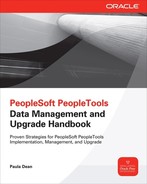
CHAPTER
10
Upgrade Overview
“Ever-newer waters flow on those who step into the same rivers.”
—Heraclitus, c. 475 B.C.
“Our new Constitution is now established, and has an appearance that promises permanency; but in this world nothing can be said to be certain, except death and taxes.”
—Benjamin Franklin in a letter to Jean-Baptiste Leroy, November 13, 1789
 oth the Greek philosopher and the Early American statesman would probably agree that the primary constant in life is change. For organizations, change is also a constant. Two primary factors motivate change in organizations: pain and gain.
oth the Greek philosopher and the Early American statesman would probably agree that the primary constant in life is change. For organizations, change is also a constant. Two primary factors motivate change in organizations: pain and gain.With regard to software, change equals upgrades, which often include new features, new interfaces, streamlined process flows, and fixes to old software problems—the gain. Software change also requires software reconfiguration, user manual updates, and current business process realignment with system process—the pain. Upgrades bring new opportunities and great potential for efficiencies. But these changes involve work and the allocation of scarce resources: labor, time, and, ultimately, money.
When perceived gains outweigh costs (when the gain seems greater than the pain), organizations implement change. Several common pain factors motivate upgrades:
■ Regulatory requirements
■ Costly support contracts
■ Discontinued support
■ Competitive pressure
When motivated by regulatory requirements, cost is irrelevant. For other pain-motivated decisions, the benefits derived from an upgrade must exceed implementation costs. The following common costs are often associated with a software upgrade:
■ Potential consulting fees
■ Hardware upgrades
■ Labor for IT and subject matter experts
■ System integration work
■ Training
■ Potential downtime and lost productivity
Does Change Require an Upgrade?
Traditionally software companies have bundled new features into periodic software releases. This was motivated by both economics and psychology. From an economic perspective, if a company is going to implement change, it often wants to implement more changes at one time rather than living in a constant state of change. That way, the company has to pay for the change only once. From a psychological perspective, users often avoid change, even positive change, for several reasons: fear and anxiety, as well as the effort required to change habits and behaviors. Longer durations between upgrades allowed software users to “settle in” to a day-to-day routine rather than live in a constant state of change.
More recently, software companies are promoting the benefits of shorter release cycles with incremental but continuous change. The “big bang” approach to software upgrades has proven to be too disruptive and costly, prohibiting many organizations from upgrading. PeopleSoft continues to release major upgrades for those who are not current. For those who are current, however, Oracle now provides periodic feature pack updates that a customer can apply to an existing system using the same techniques described in Part II of this book.
PeopleSoft Upgrades
In this part of the book, we offer tips and instruction to help your organization lower its costs when upgrading PeopleSoft software.
Compare Reports
The term “upgrade” often brings up great emotion: excitement and the antithesis—sheer terror! A demonstration of the new features, modern user interface, and simplified user experience provided by a software upgrade often generates enthusiasm and anticipation. On the darker side, upgrades bring to mind chaos, budget overruns, lost productivity, and user resistance to change.
It doesn’t have to be this dramatic, however. We’ll offer tips and instructions to help your organization lower its upgrade costs and carefully consider the appropriate options.
Compare reports identify and categorize change. Some changes require special attention, and other changes can be ignored. In Chapter 11, you will learn how to generate and interpret compare reports so that you can differentiate between changes that require attention and changes you can ignore.
PeopleSoft Test Framework
Proper testing is critical to upgrade success. Testing, however, requires people—not just warm bodies, but functional experts. Few companies have enough excess labor capacity to dedicate their brightest human resources to upgrade testing. In Chapter 12 you will learn how to use PeopleSoft’s Test Framework to build and maintain an automated test suite that can repeat the mundane tasks that normally require functional experts.
Upgrade Tips and Techniques
Upgrading PeopleSoft requires knowledge of each of the subject areas covered in this book. A complete, operating system–independent upgrade guide could easily cover 600 pages. In fact, Oracle creates version-specific upgrade guides that describe how to perform an upgrade. In Chapter 13 you will learn a few tips and techniques to streamline the upgrade process, including virtualization shortcuts.
Pain Avoidance
The Wong-Baker Faces Foundation publishes a universal pain scale used by physicians and patients to gauge pain. You can see the pain scale at http://www.wongbakerfaces.org/. On the Wong-Baker pain scale, routine maintenance ranges from 0 (doesn’t hurt) to 4 (hurts a little more). Upgrades, on the other hand, start at 4 (hurts a little more) and end somewhere around 9 (hurts a whole lot). Part II of this book covered change management regarding patches and routine maintenance. In Part III, we offer tips and instructions to help your organization stay below the “hurts a little more” range of the pain scale.
..................Content has been hidden....................
You can't read the all page of ebook, please click here login for view all page.
